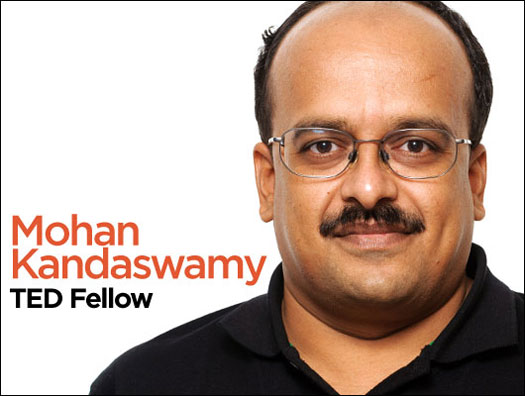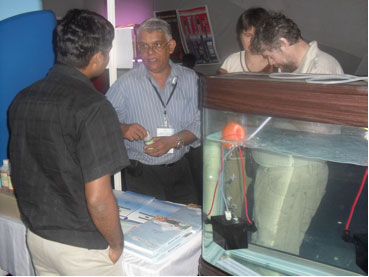
Mohan Kandaswamy commercializes a first-of-its-kind device that cleans aquaculture systems without the use of chemicals. Based in India, Mohan is expanding this technology beyond shrimp and prawn production to conserve endangered species and cleanup wastewater from mining and other industries worldwide.
Can you tell us briefly about the work you do?
I am the founder and director of Oriental Aquamarine Biotech. This is a marine biotech startup and we are working on commercializing the Nitrifying Bioreactor.
Nitrifying Bioreactors are self-sustaining systems that remove ammonia and nitrites created in aquaculture tanks and help maintain reef-quality oligotrophic conditions in the tanks. This leads to the production of higher numbers of higher-quality, larger, organic seeds and fish. The Bioreactors can be used for various aquatic species and for salt-water, fresh-water and brackish water fish species. It can work in any kind of aquaculture system, provided it is closed and doesn’t have other kinds of plant and other matter which can clog the filters.

ABOVE: Exhibiting the Bioreactors at the India International Aqua Show
This technology was developed after 16 years of research, and has applications in both the aquaculture and environmental sector.
Do you have any new developments at Oriental Aquamarine Biotech?
Yes, we have installed three reactors in fully-functional hatcheries. The work carried out so far has been on prawns and shrimps, but we would like to extend the scope of work to include scampi, cobia, seabass, freshwater ornamental fish, marine ornamental fish, and other aquatic species. The use of our technology can help in breeding species that have not been commercially bred in aquaculture systems to date.
We’ve also initiated a new project on conservation of turtles and started a joint project for breeding of seahorse, which is now an endangered species in the country [India].
One of your passions is swimming. Is this connected to your work?
No, I just swim 1,250 meters every day — about 25 lengths of an Olympic-sized pool. And a little bit of SCUBA diving. In some ways SCUBA diving is connected to the work, in terms of collecting species and things like that.
Read more of this interview with Mohan Kandaswamy after the jump >>
(Continued)
How has the TED Fellowship affected your life?
The primary benefit of the TED fellowship was in terms of exposure to a large number of people doing great work in their respective areas.
At the TED Conference a key person I met was Romulus Whitaker, who gave a talk about snakes. He in fact is undertaking a project on turtle conservation. So we have been in constant touch with him, and we should come up with some project in which we will install the reactor on a large-scale basis. We hope it will become a model for conservation projects worldwide.
The second one I met was marine biologist Dr. Charles Anderson. We are exploring overseas markets and Dr. Anderson has contacts in areas like Mauritius. Besides India, we already have patents in countries including Thailand, Japan, Philippines, South Korea and Indonesia, and we have had expressions of interest from the UK and the US
Discussions during the conference with other attendees also revealed that there are applications in environmental areas and wastewater treatment for the Bioreactor — ammonia is a problem in other industries as well. Our project is the first of its kind in the industry worldwide, and the TED Fellowship has led to expanding the application of this technology beyond the aquatics industry.
How will you be collaborating with Dr. Whitaker’s turtle conservation project?
Dr. Whitaker founded the Madras Crocodile Bank Trust in Chennai. The Crocodile Park is for conservation as well as for showcasing different varieties of crocodiles, and they are now getting into turtle conservation. Currently they have not been able to breed turtles in captivity. The reason for this is the inability to maintain water conditions.
The thing is, to breed a marine species, you should have a water quality which replicates ocean water conditions. And that is what is technically called “reef-quality oligotrophic” conditions. We have met the officials at the Crocodile Park and explained that we can replicate reef-quality oligotrophic conditions in a captive environment — in a tank we can replicate conditions prevailing on the bed of the sea.

ABOVE: The Stringed Bed Suspended Bioreactor
So they have submitted proposals to their funding agencies for further funding of this project. And once that comes in we should be able to implement this project at Chennai. This conservation of turtles and breeding of turtles in captivity can be expanded to other kinds of species as well. We will start with turtles and take it forward in other areas.
You mentioned that the TED Conference helped you recognize the potential of your bioreactor to help industries that have wastewater as a byproduct. What industries might benefit from your bioreactor?
Any industry where ammonia is present as the effluent is a prospective customer.
Currently in fact a market survey is now on and what we could get from the survey is that the pharmaceutical industry and the fertilizer industry have a lot of ammonia in the wastewater — that is one application in India.
One potential partner from Canada is a company that extracts metals using an ammonia-leaching process. They have very high levels of ammonia in their effluent wastewater. The environmental authorities in Canada would like the effluent to pass the fish-in-pond test. That is, the effluent from the factory has to go into a pond, and then the fish has to be put inside, and has to survive for three days. Only then the water can be let out.
The current method of treating ammonia is a chemical process which is extremely energy-consuming. And they found that our kind of biological system could be much faster and more efficient and the whole process can be done at a fraction of the cost. This is another application. So the three major applications would be: mineral extraction, pharmaceuticals, and fertilizer industry.
What are your future plans for your company?
We want to set up a model hatchery where we can demonstrate how this bioreactor can be used for cost-effective aquaculture of different species — as I mentioned, prawns, shrimp, scampi, cobia, seabass, marine ornamentals, freshwater ornamentals and turtles. We wanted to have a kind of model hatchery and we are looking at funding options for this project from different sources.
In South American countries certain organic aquaculture projects — aquaculture without any antibiotics and chemical agents — are currently being promoted. We hope to connect with these kinds of companies. The key thing in our system is that it works based on a bacterial consortium and we do not recommend any kind of chemical inputs in the production process. So the fish that come out of this system are chemical-free, and it’s the first step towards organic sustainable aquaculture.
Comments (1)